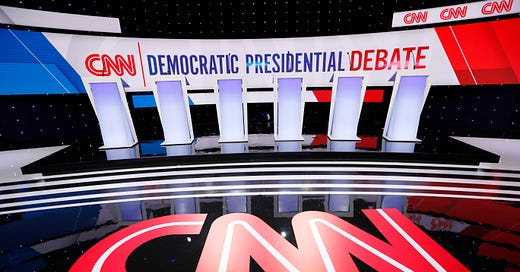Related highlights:
—
The New York Times came this close to having a moment of self-realization.
The paper of record published a profile this month on former alt-right YouTuber Caolan Robertson, characterizing his methods of promoting far-right viewpoints, all while growing a sizeable online audience, as exceptionally devious and innovative.
The funny thing is: There is nothing original or ingenious about Robertson’s tactics, especially his use of staged confrontations and selectively edited interviews. Indeed, major newsrooms have fed and grown their audiences for decades using the same techniques described by the former alt-righter.
If anything, Robertson’s story is a bit like that old anti-drug PSA from the 1980s, in which the son tells his father, “I learned it from watching you!”
Consider, for example, the subhead to the New York Times’s expose, which reads, “Focus on conflict. Feed the algorithm. Make sure whatever you produce reinforces a narrative. Don’t worry if it is true.”
This is just a rewording of the old journalism maxim, “If it bleeds, it leads.”
Robertson himself admits his videos were produced with an eye toward sensationalism and confirmation bias, right down to the wording of the titles as they appear on YouTube.
“We would choose the most dramatic moment — or fake it and make it look more dramatic,” he told the New York Times. “We realized that if we wanted a future on YouTube, it had to be driven by confrontation. Every time we did that kind of thing, it would explode well beyond anything else.”
The New York Times itself reports, “The videos were tailored for the ‘echo chamber’ that is often created by social media networks like YouTube.”
This sounds an awful lot like Katie Couric’s deceptively edited interview with Virginia gun rights advocates. Couric and her producers doctored the interview to highlight confrontation and omit crucial, exculpatory context, and all for the benefit of a very specific audience.
This also sounds a bit like when the national press promoted a truncated video to wrongly accuse Cherokee County Sheriff's Capt. Jay Baker of sympathizing with the 21-year-old suspect who allegedly shot and killed eight people in Atlanta-area massage parlors, showing just the out-of-context moment where the officer said the suspect had a “really bad day.” This was not Baker’s personal assessment. Rather, he only paraphrased what the suspected shooter had told investigators.
What the New York Times describes also sounds an awful lot like the news media’s unsuccessful and grotesque 2019 attack on Nick Sandmann, the then-Kentucky teenager who, based on a single context-less video, was wrongly accused of verbally abusing an elderly Native American near the steps of the Lincoln Memorial.
“Knowing what garnered the most attention on YouTube, Mr. Robertson said, he and Ms. Southern would devise public appearances meant to generate conflict,” the New York Times reports. “That December, they attended a women’s march in London and, with Ms. Southern playing the part of a television reporter, approached each woman with the same four-word question: ‘Women’s rights or Islam?’”
This sounds exactly like CBS News’s recent hit job on Florida Gov. Ron DeSantis, in which 60 Minutes reporter Sharyn Alfonsi attended a press conference for the sole purpose of falsely accusing the Republican executive of rewarding a grocery chain with an “exclusive” deal to distribute coronavirus vaccines as part of a “pay for play” scheme involving political contributions.
Like Robertson, CBS edited relevant context from DeSantis’s response to Alfonsi, including his lengthy and careful answer detailing the full scope of Florida’s vaccine distribution program. Rather than provide audiences with all the necessary information, 60 Minutes instead aired footage of Alfonsi repeatedly yelling, “It’s pay-to-play, governor?” and DeSantis meekly responding, “It’s a fake narrative.”
In fact, the biggest difference between Robertson and the press is the press has a lot more practice misleading people for ideological and audience engagement reasons.
Indeed, whether it's doctoring videos to report falsely that Toyota vehicles suffer from “unintended acceleration" issues, falsely accusing the late former President George H.W. Bush of being befuddled by grocery store scanners, or editing video of former Attorney General William Barr to make it appear as if he admitted the Justice Department's decision to drop charges against former national security adviser Michael Flynn was a “political hit job,” the press has been at this game a long, long time.
In fact, it was just last week that the front pages of the New York Times, the Washington Post, and the Los Angeles Times featured images from a staged photo-op of President Joe Biden at Arlington National Cemetery, hyping his decision to withdraw all U.S. troops from Afghanistan.
Speaking of men using powerful platforms to disseminate propaganda, the late "journalist" Walter Duranty was laundering Soviet agitprop through the pages of the New York Times well before Robertson’s home country of the Republic of Ireland was officially declared a republic. The New York Times, by the way, didn’t get around to disavowing Duranty until 1990, just one year before the fall of the Soviet Union.
There are additional differences between Robertson and the press, including that the latter has a lot more influence, institutional power, and money. Another key difference is that, unlike when major newsrooms are caught peddling disinformation, journalists take Robertson’s specialized brand of propaganda seriously.
Obviously, none of this is intended as a defense of the alt-right. Rather, it’s an attempt to point out that many newsrooms play by the same rules Robertson and New York Times rightly characterize as dangerous and harmful.
Would that we be so lucky that members of the press read the Robertson expose and experience an epiphany.




